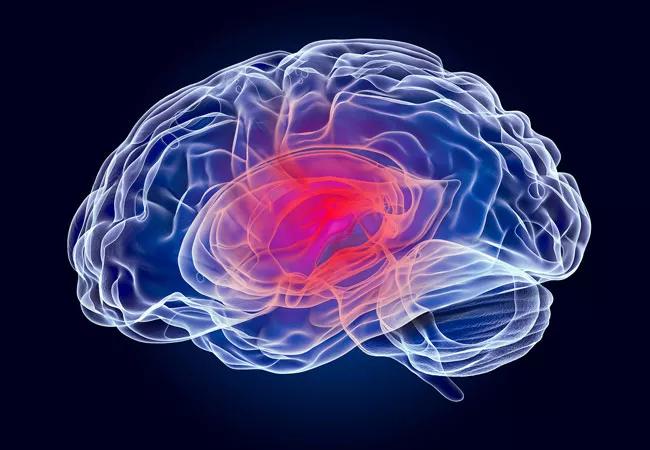Longitudinal study implicates a specific pathway in mild cognitive impairment stage

A growing body of research suggests that inflammatory changes play a role in Alzheimer’s disease (AD) pathology, but further study is needed to better understand the exact role these changes play and what specific pathways regulate them. It also remains unclear whether and when inflammatory changes could be useful disease biomarkers in patients.
Cleveland Clinic is a non-profit academic medical center. Advertising on our site helps support our mission. We do not endorse non-Cleveland Clinic products or services. Policy
These uncertainties prompted researchers at Cleveland Clinic to conduct a longitudinal clinical study that found cognitive and functional decline during the mild cognitive impairment (MCI) stage of AD to be impacted by key pro-inflammatory changes in baseline levels of immune cell chemotactic cytokine CCL2 in the cerebrospinal fluid (CSF) and by IL-10 pathway dysregulation. In the study (Ann Clin Transl Neurol. 2020;7[7]:1225-1239), the researchers further evaluated how CCL2 compared with biomarkers of neurodegeneration, including MRI measures of hippocampal volume and CSF neurofilament light.
“There have been a number of unanswered questions surrounding the role inflammation plays in AD,” notes the study’s lead author, Jagan Pillai, MD, PhD, of Cleveland Clinic Lou Ruvo Center for Brain Health. “Our study and its results help us gain further insight into which inflammatory pathways impact disease progression and could therefore provide a potential therapeutic target opportunity for these patients.”
Efforts to identify inflammatory pathways related to cognitive decline in AD patients must involve examination of numerous analytes at the same time while taking a closer look at their clinical value when expressed together. Recognizing this, the study authors took a systematic approach.
Their longitudinal study was conducted in patients with MCI plus CSF biomarkers consistent with AD (MCI-AD). It included investigation of a Discovery cohort (n = 48) for 15 months followed by a replication analysis among MCI patients in the Alzheimer’s Disease Neuroimaging Initiative (ADNI) cohort (n = 134) over 36 months.
In multivariate regression models, the researchers assessed inflammatory analytes that predict clinical progression on commonly used clinical scales — specifically, the Clinical Dementia Rating Scale – Sum of Boxes (CDR-SB) and the Mini-Mental State Examination (MMSE) (see figure). Additionally, key analyte results from the ADNI cohort were compared against biomarkers of neurodegeneration, hippocampal volume and CSF neurofilament light.

Figure. Overview of the study design. Reprinted from Pillai JA, et al., “Inflammatory pathway analytes predicting rapid cognitive decline in MCI stage of Alzheimer’s disease,” Annals of Clinical and Translational Neurology (2020;7[7]:1225-1239). ©2020 The Authors.
Another unique aspect of this research, according to Dr. Pillai, is that it simultaneously measured analytes in both CSF and plasma. “This allows for a better understanding of what is going on in these two different domains and the impact on disease progression,” he explains.
“Additionally, rather than randomly choosing one or two analytes to examine, we measured over 53 different analytes,” he adds. “As a result, we were able to look at the broad pattern and posit a pathway-related change.”
The findings demonstrated that cognitive decline among MCI-AD patients was best predicted by CSF CCL2, which supported results from other reports. Through characterization of chemokines grouped closely with CCL2 in CSF and plasma, Dr. Pillai and his team highlighted the correlation between dysregulation of the IL-10 inflammatory pathway and clinical progression in this patient population.
Moreover, the researchers reported that baseline CSF CCL2 was comparable to CSF neurofilament light and hippocampal volume in effectiveness for predicting rapid cognitive decline but — strikingly — did not correlate with the neurodegeneration biomarkers. “This suggests that they capture information from different pathobiological signatures and could be dysregulated differently in different patients,” Dr. Pillai observes.
He notes that the study has two important takeaways. “First, our research suggests that disease progression is related to a specific pro-inflammatory pathway,” he says. “Second, we found that inflammation-related markers are as effective as neurodegeneration markers — the current gold standard — in predicting which patients at the MCI stage of AD will face worsening disease.”
These findings shed additional light on the role of inflammation in AD progression, opening the door to new research avenues. Current investigative efforts by Dr. Pillai and his Cleveland Clinic colleagues are focused on the biology underlying these findings.
“Our study highlights the differences in inflammation response,” he notes. “Some patients have a strong pro-inflammatory response that drives disease progression, whereas others have a strong anti-inflammatory response. We need to understand why this is the case.”
Additional research should further probe the clinical implications of the current study, according to Dr. Pillai. “It raises the question of whether patients need to be targeted for the inflammation-related pathways that are more likely to cause disease progression,” he says.
The implications of these findings go beyond AD, he adds, as similar inflammation-related changes have been observed in other conditions. Therefore, a common pathway may cause worsening cognitive outcomes across multiple neurological diseases.
“If that’s the case, we need to learn more about how those insights might help customize care, not only in Alzheimer’s disease but for other neurological conditions affecting cognition,” Dr. Pillai explains. “In future research we’d like to understand how much of the effect of CCL2 is applicable to cognitive outcomes in other diseases.”
Noting that there’s a sense that little progress is being made in AD research, he concludes: “Studies like this remind us that our understanding of the disease and what causes progression is growing significantly and this growth will help us find effective targeted therapies.”

Pilot study confirms feasibility of conducting additional research on the novel treatment

Longer hospitalization does not mean a safer, faster recovery for patients age 70+

Structured data helps identify older adults at risk for poor outcomes, defines patients who require more comprehensive assessments

Self-administered tool can be completed in 10 minutes in waiting room

Social prescribing turns leisure activities into good “medicine”

A large geriatric study aims to find the answers

Analysis underscores how telehealth can help pinpoint elder abuse